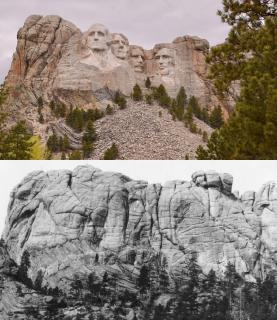Protect the Land
By Kyra Bellamy
On September 13, 2007, the United Nations Declaration on the Rights of Indigenous Peoples (UNDRIP) was adopted by the General Assembly. It provides a universal framework mandating that Indigenous people around the world be treated with dignity, recognizing their human rights and fundamental freedoms. A majority of the states that voted were in favor of the declaration; however, four were not. The United States, Canada, New Zealand, and Australia voted against it, though in recent years they’ve changed their positions.
Throughout this article, historical events involving Indigenous people from around the world will be explored with an understanding of how following UNDRIP should change things in favor of Native communities instead of favoring settlers, government, and industry.
In recent news, controversy has arisen after a press release reported that Mark Zuckerberg, creator of the social media platform Facebook, is suing hundreds of native Hawaiians for their land. Beforehand, Zuckerberg had purchased a 700 acre plot of land on the island of Kauai for a total of $100 million.
The beginning of this injustice started in December 2016, when Carlos Andrade sent letters to several of his family members informing them that he was going to sue them. Carlos Andrade is the great-grandson of Manuel Rapozo, one of hundreds of individuals that own parcels of land on the island of Kauai. A neighboring landowner, Northshore Kalo LLC, offered to assist Andrade’s relatives with the legal issue, as well as payment for legal fees. The proposed arrangement would allow Andrade to take full ownership of the properties and then compensate his relatives that live on said land. Northshore Kalo LLC was revealed, however, to be a shell corporation owned by Mark Zuckerberg himself. Zuckerberg was pursuing eight different lawsuits with individuals who were native to the parcels of land his recently-purchased territory surrounded. The people living in said parcels could either sell their share or try to out-bid a billionaire in a public auction. If they lost, they would then have to pay additional legal fees.
Even though Zuckerberg isn’t directly suing the Indigenous people themselves, the whole interaction between the Hawaiians and Zuckerberg definitely makes a mockery of the Indigenous sovereignty over the land and shows the unjust system where native Hawaiians have continuously lost their land to wealthy settlers. Under the UNDRIP, Article 26-2, “Indigenous peoples have the right to own, use, develop and control the lands, territories and resources that they possess by reason of traditional ownership or other traditional occupation or use, as well as those which they have otherwise acquired.” In this situation, Mark Zuckerberg violated the declaration, which allows native Hawaiians control over land that’s been in their family for generations.
There are about 370 million Indigenous people between 70 countries worldwide. The two synonymous terms indigenous and native are defined as a place-based human ethnic culture that has not migrated from its homeland—people that are not settler or colonial population. The story of Mark Zuckerberg versus native Hawaiians isn’t the first of its kind. In fact, the story has been told countless times throughout global history. Indigenous people have been forced out, bought out, and tricked out of land that was originally theirs.
In the history of the United States alone, there have been plenty of controversial land ownership disputes. More than 370 ratified treaties have granted the U.S. access to expand its territory further west, which lead to many broken promises to the Indigenous communities who lived there for thousands of years. In the early history of the United States, European settlers signed several treaties with the Indigenous peoples, and in most cases used genocidal tactics to massacre and forcibly remove large groups of people, claiming for the United States rights to land that makes up modern day America.
Article 10 of the UNDRIP states that, “Indigenous peoples shall not be forcibly removed from their lands or territories. No relocation shall take place without the free, prior and informed consent of the indigenous peoples concerned and after agreement on just and fair compensation and, where possible, with the option of return.” Although the UNDRIP was adopted centuries after the birth of the United States, hundreds of thousands of Native Americans were not given the privilege of free, prior, or informed consent when they were forcibly removed from their land to make room for new white settlers.
In New York City where the United Nations is headquartered, the land was originally inhabited by the Lenape. Once the Dutch arrived in 1626, they purchased the land for a little money and some trinkets. The story is believed to show that the Lenape thought they were only giving the land as a loan, so the Dutch could use it for that period of time while the Lenape still owned it. They were soon forced out of their homes and the Lenape island of Manahatta became known as Manhattan.
Not only did European colonizers take land from the natives, sacred landmarks were also included. Many were renamed, stripped of their native names, and some were even completely destroyed and remodeled—one in particular being Mount Rushmore.
The land that Mount Rushmore sits on was originally known as the Black Hills. The naturally-made mountain originally named “the Six Grandfathers,” or “Tȟuŋkášila Šákpe,” belonged to the Sioux people, who were native to the Black Hills for generations before European settlers arrived. In the Treaty of 1868, the United States government promised the Sioux people that they would have sovereignty in perpetuity over territory that included the Black Hills. But after gold was found in the mountains, the government forced the Sioux to give up the Black Hills portion of their reservation. Because many refused to assimilate under Ulysses S. Grant’s instruction, a war followed. In the ensuing massacre, armed U.S. troops came in and killed hundreds of unarmed Sioux men, women, and children.
Several years after that, in 1927, a man named Gutzon Borglum was hired by Doane Robinson, a historian who was looking for a way to attract more tourists in South Dakota. He wanted to create a sculpture “to honor the West’s greatest heroes, both Native Americans and pioneers.” Borglum himself insisted that instead he should carve the faces of notable United States presidents and was granted the access. So, for the next 14 years, Borglum carved the faces of George Washington, Abraham Lincoln, Thomas Jefferson, and Theodore Roosevelt into what was formally known as the Six Grandfathers.

Above: the completed Mount Rushmore monument. Below: the Six Grandfathers, the mountain into which the monument was carved, on land taken from the Sioux.
In the case of Mount Rushmore, Gutzon Borglum violated UNDRIP Article 32-1, which acknowledges the right of Indigenous peoples to “determine and develop priorities and strategies for the development or use of their lands or territories and other resources.” Mount Rushmore was built on land thegovernment took from the Sioux; the Black Hills are considered sacred ground and Mount Rushmore celebrates the European settlers who killed Native Americans and appropriated their land.
Although Mount Rushmore was a pre-UNDRIP violation of Indigenous land, the same cannot be said of the construction of the Dakota Access Pipeline (DAPL). The oil pipeline was to be built almost 1,200 miles long, extending from the oil fields in Bakken, North Dakota to Illinois. Although some celebrated the fossil fuel project, Indigenous Sioux peoples on the Standing Rock Reservation were not happy with the prospective pipeline construction in 2016. Pipeline protestors calling themselves “water protectors” were afraid that if the pipeline was built less than a mile from their land, a possible oil spill would pollute the water that they use for drinking water, fishing, and religious ceremonies. Under the Obama administration, the tribe sued the Federal District court in Washington D.C., halting the project in 2016. Four days after Donald Trump took office in 2017, however, he signed an executive memorandum directing for the pipeline to be reviewed and approved expeditiously.
Recently, United States District Judge James E. Boasberg found that the pipeline was highly controversial and ordered the United States Army Corps of Engineers to conduct a more in-depth environmental impact statement, halting everything. UNDRIP Article 8-2 states that, “States shall provide effective mechanisms for prevention of, and redress for:any action which has the aim or effect of dispossessing them of their lands, territories or resources.” The Dakota Access Pipeline prevented the Sioux people on the Standing Rock Reservation from potentially having access to clean water, as well as their daily activities or rituals. State support for the pipeline was in violation of UNDRIP; it seemed as though the only people who saw any importance of this land violation were the people indigenous to the land.
All over the world and all over the country, Indigenous peoples have been tricked or forcibly moved out of their land. From the time European settlers set foot on North American soil to DAPL and Mark Zuckerberg, Indigenous peoples are constantly being removed from their land because of wealthier and more powerful newcomers.
It is important that all of us are active in solidarity with Indigenous communities and water protectors to uphold UNDRIP. We must treat the Indigenous people of all lands with the upmost dignity that the UNDRIP demands and protect their land at all costs.
